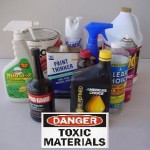 What you don’t know can hurt you. “I didn’t know.” In these words lies the story of countless deaths and injuries in countless homes.
What you don’t know can hurt you. “I didn’t know.” In these words lies the story of countless deaths and injuries in countless homes.
About one-half of the accidental deaths of children occur in the home— from falls, suffocation/choking, scalding, poisoning, and burning. Elderly persons, likewise, are subject to greater dangers because of infirmities and impaired faculties. Yet the concern about home accidents is not only for the very young or the very old. Accidents at home can strike people of all ages.
Every year, over two million poisonings are reported to Poison Control Centers across the country, and more than ninety percent of those happen in the home. The majority of non-fatal poisonings occur among children younger than six years, and poisoning is one of the leading causes of death among adults.
The medicine cabinet is a favorite attraction for curious young children. It is not enough to put poisons and certain types of medicines on high shelves because exploring children like to climb. Dangerous substances need to be locked up.
A significant number of children are being poisoned by consuming medicines brought into the home by grandparents or visitors. Poisonings also have occurred when youngsters have visited homes where no children live.
Substances which can cause accidental poisoning in children also are found outside the medicine cabinet. The list is a lengthy one—detergents, cleaning compounds, insect sprays, paint thinners, and antifreeze, just to name a few.
Children are not the only victims of accidental poisoning. Every year, there are numerous cases of men and women who poison themselves unintentionally. To help prevent a tragic accident in your home, follow safety-wise guidelines.
Keep household products separated. Take care that foods are not exposed and become contaminated when you use insect sprays, cleaning agents, and rodent poisons.
- Containers with flammable liquids should be clearly labeled.
- Flammable liquids such as gasoline should be stored in a cool, well-ventilated place, not inside the home.
- Never pour flammable liquids down sinks or other drains.
- Store medicines and cleaning supplies in locked cabinets out of children’s reach.
The Centers for Disease Control report that about 12,000 children every year are victims of poisonous plants or berries they have ingested, or in some cases, just put into their mouths. Most persons are reasonably familiar with dangerous outdoor plants, such as poison ivy, oleander, or deadly nightshade, but what they do not know is even some of the most common houseplants can cause serious, even fatal reactions. For example, tea brewed from mistletoe berries is lethal and rhubarb leaves (not the stalks) contain oxalic acid, which can cause severe kidney damage.
One home safety issue that is not well-publicized regards pressurized containers. Pressurized containers have revolutionized packaging economy, but caution is necessary in their use. Never incinerate a pressurized container. The heat will cause the air inside to expand, which, in turn, may cause the container to burst. Read the warning message on the container to find out if the mixture is flammable. Keep pressurized containers away from children.
Keeping home safety in mind at all times can mean the difference between a happy home environment and a tragedy.
Note: See the following article for additional information on home safety and children, http://www.nanny.net/blog/9-most-common-household-poisons/
- What’s Brewing – Tea – National Tea Day - April 19, 2024
- Stress Around the Clock - March 22, 2024
- WOW! Your Guests with Holiday Baking - December 15, 2022
